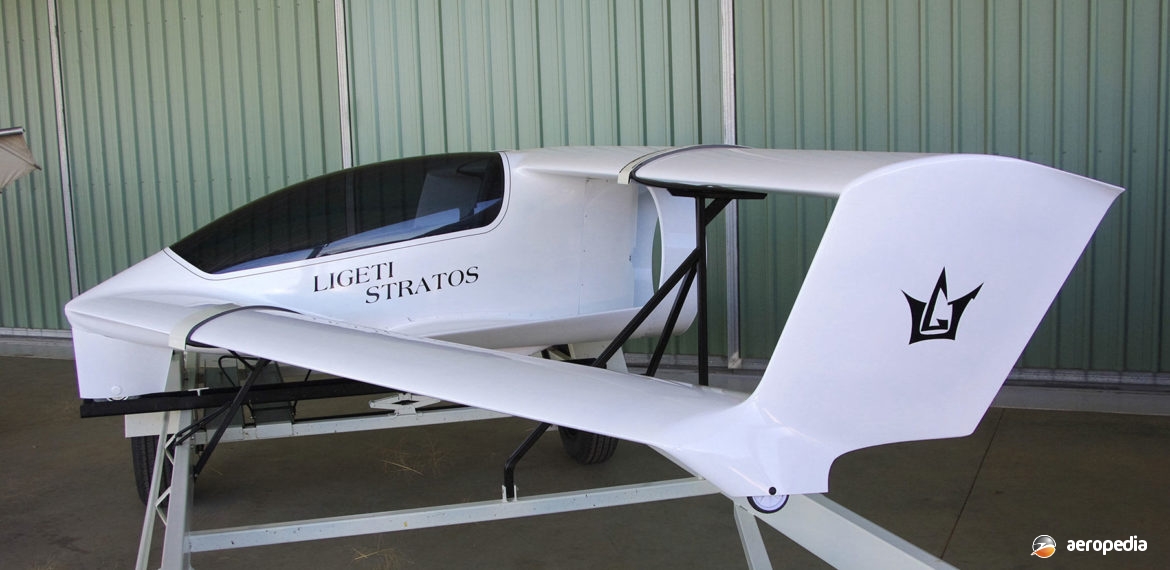Photograph:
Restored Ligeti Stratos at Temora, NSW in 2012 (David C Eyre)
Country of origin:
Australia
Description:
Single-seat light aircraft
Power Plant:
One 21 kw (28 hp) Koenig SD-570 four-cylinder two-stroke air-cooled radial engine
Specifications:
- Wingspan [upper rear wing]: 5.3 m (17 ft 5 in)
- Wingspan [forward wing]: 5.09 m (16 ft 7 in)
- Length: 2.49 m (8 ft 2 in)
- Height: 1.02 m (3 ft 3 in)
- Wing area: 7.52 m² (80.7 sq ft)
- Design load factors: +9/-6 G
- Max speed: 200 km/h (124 mph)
- Cruising speed at 75% power: 180 km/h (112 mph)
- Economical cruising speed: 161 km/h (100 mph)
- Stalling speed power on: 58 km/h (36 mph)
- Max rate of climb at sea level: 204 m/min (670 ft/min)
- Service ceiling: 4,499 m(14,760 ft)
- Range: 723 km (449 miles)
- Empty weight: 78 kg (172 lb)
- Loaded weight: 188 kg (414 lb)
History:
Charles Ligeti in 1982 built a hang-glider for the ‘Australian Bird Man Rally’ and then went on to design the Stratos, the prototype of which flew on 25 April 1985 for 45 minutes. The aircraft was then taken to the United States and flown at the EAA Airshow at Oshkosh, at the Airfair at Seattle, and the World Expo at Vancouver, in 1986. The prototype had a 18 kw (24 hp) three-cylinder Konig engine. Of unusual configuration, the wing spars used carbon fibre for spar caps and Kevlar for shear webs in the centre section to achieve high manoeuvrability. The canard and main wings had ailerons, and the main wing had flaps. The vertical fins acted as rudders. The undercarriage was a fixed tandem type with small outrigger wheels on the canard tips.
In 1986 Howard Investments Pty Ltd and Ligeti Aeronautical Pty Ltd formed a joint venture to market the aircraft. By this time a number of changes had been made to the Stratos, including increases in the length, width, and height of the fuselage, and alterations to the engine mounts allowing the Koenig 4-91 engine to be fitted in an optimal position. The wing area was increased, this being achieved by moulding the wings with only a sandwich foam in lieu of the solid foam in the prototype.
In April 1986 a production run of 20 aircraft was commenced, and proposals were announced to move production to larger premises where up to 40 aircraft per year could be constructed. The fitting of a 48 kw (65 hp) Rotec engine was also considered. However, Charles Ligeti was killed in a test-flight crash in Melbourne on 22 September 1987. Later Ligeti Aeronautics announced it would continue development, including a Mk 2, a two-seat variant, fitted with a four-cylinder Koenig engine.
Rec0rds indicate three examples were built. The first, noted above, crashed whilst flown by Charles Ligeti. At the time it had flown some 340 hours but had received some changes including the removal of the dihedral from the main wing and the use of full-span elevators on the canard wing, the engine mount was lowered and the ducted propeller was totally below the main wing and the lower part of the propeller duct was extended well forward to form a “channel or strake”. The changes were made to lower the stalling speed and reduce both landing and take-off speeds and distances. However during testing near Penfield, VIC on 22 September 1987 control was lost and the aircraft struck the ground in an inverted attitude and the pilot, Mr Ligeti, was killed.
The second aircraft also crashed. Some records indicate the three were placed on the RAAus Register but the registrations eventually lapsed. the second example, described as an LGT Aero Nautical Stratos, crashed at Mangalore injuring the pilot and it was restored to static display standard at Holbrook for the Australian Ultralight Museum. This aircraft 19-7441 (c/n S3-001) is on a specially-built trailer and is fitted with a 19 kw (26 hp) Koenig SC-430 engine. The third was only a fibreglass shell and was not completed but has survived, has received some attention, being placed on display at a museum in the Ballarat / Bendigo area, VIC.

